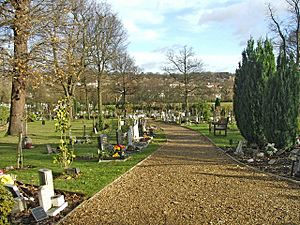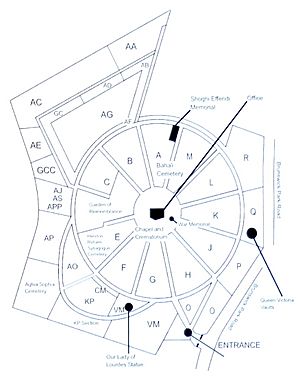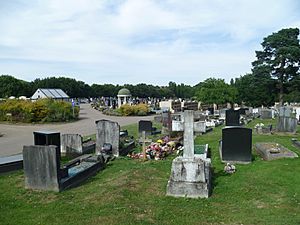New Southgate Cemetery facts for kids
New Southgate Cemetery is a large, peaceful cemetery in Brunswick Park in London. It covers about 22 hectares (that's like 54 football fields!). It was first opened in the 1850s by a company called the Colney Hatch Company. Back then, it was known as the Great Northern London Cemetery. It even had a special train service that ran from near King's Cross station in central London right to a station at the cemetery! This was similar to another cemetery service that went to Brookwood Cemetery in Surrey.
The special train service to the Great Northern London Cemetery didn't last very long. But the cemetery itself has stayed open ever since.
Contents
The First Cemetery and Its Special Train
After the 1850s, many old burial grounds in central London were closed. People realized they needed new places to bury the dead, further away from the busy city center. New laws were made, like the Cemeteries Clauses Act 1847, which allowed companies to create new cemeteries.
The Colney Hatch Company bought land for a cemetery near a place called Colney Hatch. This area is now known as New Southgate. The name was changed later to avoid confusion with a nearby hospital. The cemetery was planned to be very big, covering about 150 acres.
The cemetery was located about 1 mile (1.6 km) north of what is now New Southgate railway station. This station is about 7 miles (11 km) north of King's Cross station on the Great Northern Railway line. King's Cross station had only opened a few years before, in 1852.
In 1855, the Great Northern London Cemetery Company was formed. This was a partnership between the Great Northern Railway Company and the Colney Hatch Company. Their goal was to offer affordable and easy burial services for people living in central London.
Another similar train service had started in 1854. It ran from near Waterloo station to Brookwood Cemetery in Surrey. However, that journey was about 23 miles (37 km) long and took around 45 minutes. The trip from King's Cross to Colney Hatch was much shorter, only about 15 minutes.
The Great Northern London Cemetery Company wanted to help people who didn't have a lot of money. They charged 6 shillings to carry a coffin. Each person attending the funeral paid 1 shilling and 6 pence for a return train ticket. The burial fee itself started at 10 or 11 shillings. This was much cheaper than Brookwood Cemetery, where burials started at over £1.
A special railway track was built next to the main line, just north of King's Cross station. There was a separate station building for the cemetery, called Great Northern Cemetery Station. This station had a unique, pointed roof and gothic-style arches. It was built above a retaining wall next to the railway tracks, which were in a deep cut. The station also had a special room for bodies, called a morgue. This helped families avoid keeping bodies at home, which wasn't very clean. There were also rooms for mourners, and a lift to carry coffins down to the trains.
The train services began around 1861. Trains ran twice a week to the Southgate & Colney Hatch station (now New Southgate railway station). From there, a single railway track led to a final stop right next to the cemetery. This stop had waiting rooms and chapels. The cemetery itself was designed by Alexander Spurr. He laid it out in a circular pattern around a beautiful Gothic chapel with a tall, 150-foot (46 m) spire.
The train services stopped sometime after 1873. The special station and its chapel were taken down after 1912. Today, a business park stands where the station used to be.
New Southgate Cemetery Today
Even though the train service ended, the cemetery continued to be used for burials. It was later renamed New Southgate Cemetery.
Many people are buried here, including the cemetery's designer, Alexander Spurr (who died in 1873). Ross McWhirter (1925–1975), famous for co-founding the Guinness World Records, is also buried here. Perhaps the most well-known person buried at the cemetery is Shoghi Effendi (1897–1957). He was an important leader in the Baháʼí Faith. He died while visiting London in 1957, and his faith says he should be buried close to where he passed away. In 1957, a crematorium (a place where bodies are cremated) was also opened at the cemetery.
Dorothy Lawrence (1896–1964) is another interesting person buried here. She was a woman who secretly pretended to be a male soldier during World War I. She later lived at a special hospital nearby and died in 1964. She was buried in a "pauper's grave," which means it was a burial for someone who couldn't afford a private plot. The exact spot of her grave is no longer clear.
Other notable people buried here include:
- Richard Bethell, 1st Baron Westbury (1800–1873), a statesman.
- Alfred Baring Garrod (1819–1907), a doctor.
- Fred W. Leigh (1871–1924), a songwriter.
- Edmund Trebus (1918–2002), who was known for collecting many things.
The cemetery was bought by the New Southgate Cemetery and Crematorium Company in 1993. Today, it has special sections for different communities. These include areas for Roman Catholic, Greek Orthodox, and Caribbean burials. Some parts of the land that used to be part of the cemetery are now a modern housing estate.
Since the 1950s, New Southgate Cemetery has become a popular burial place for the Greek Cypriot community in North London. The Greek Orthodox area was created in 1998. It is named after Reverend Kyriacou Petrou, a local priest who is also buried there.
The cemetery is also recognized as a Site of Nature Conservation Interest. This means it's an important place for nature in the local area. The Pymmes Brook Trail, a walking path, runs along the eastern edge of the cemetery.
War Graves
The cemetery is also home to the graves of soldiers who died in wars. There are 109 graves of soldiers from the Commonwealth countries. There are also two Belgian soldiers and 51 German prisoners who were buried here from a nearby internment camp during World War I. In addition, there are 86 graves of Commonwealth soldiers from World War II.
A special monument called a Cross of Sacrifice stands in front of the cemetery chapel. For soldiers whose graves couldn't have headstones, their names are listed on a Screen Wall memorial for World War I and a Kerb Wall memorial for World War II. The monument for the German prisoners is a grade II listed structure, meaning it's an important historical building.
Images for kids
-
Monument at the resting place of Shoghi Effendi






